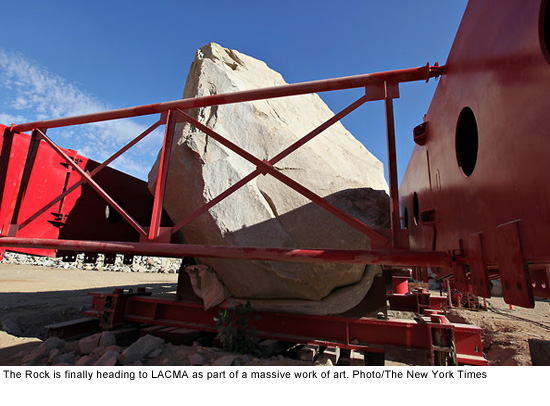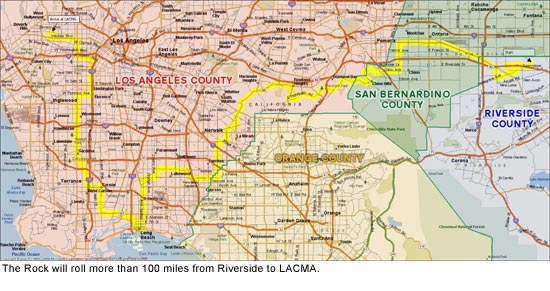Where’s The Rock?
October 13, 2011
For months, Los Angeles art fans have anticipated the arrival of the 340-ton boulder that will be the centerpiece of Michael Heizer’s massive new installation at the Los Angeles County Museum of Art.
The Rock, as its minders have come to call the massive hunk of granite, was supposed to roll to Los Angeles in August from the Riverside-area quarry where, since 2005, it has been patiently waiting. The slow-speed odyssey, on the bed of a special truck, is expected to be almost as epic as the artwork, when it is finally completed.
Now, after many false starts and much speculation, a route has been finalized (click here for a map) and The Rock has a new date of departure—October 25, according to LACMA Director of Communications Miranda Carroll and the company orchestrating the move, Portland-based Emmert International.
So what’s been the holdup?
“Well,” jokes Carroll, quoting LACMA associate vice president John Bowsher, “you can’t hurry art.”
The more detailed explanation is that it’s not easy to transport a hunk of stone the size of a 2-story granite teardrop along more than 100 miles of urban surface streets and through the bureaucracies of four counties and more than a half-dozen municipalities.
Just assembling the transporter has been time-consuming. Custom built to The Rock’s dimensions, the special 2-truck contraption, whose segmented design has been compared to a caterpillar, has had to be assembled at the quarry, where the mover’s crews have tested and retested it.
Emmert specializes in transporting buildings, transformers, satellites and other massive objects, but unlike a piece of equipment, The Rock cannot be cut into components or easily strapped down.
Its weight, combined with its transport system, will total 1,210,300 pounds, says Emmert’s director of operations, Mark Albrecht. And because it is not just a boulder but part of an artwork, it must arrive at LACMA intact—no chips, no scratches.
So part of the time has been consumed in arranging the transporter’s complex system of tires and axles so that The Rock is secure and the weight is spread safely. Albrecht says each axle line will carry about 49,000 pounds, less than the weight spread of a standard tractor-trailer, and The Rock will be nestled on a special sling atop them.
“The thing fell off a 400-foot cliff when they blasted it out of the quarry, so I don’t think we can hurt it,” jokes Albrecht. “But we’re still handling it with kid gloves.”
Albrecht says preventing the rock from taking out traffic signals and low-hanging wires has been a major undertaking. He and his crews have had to coordinate with nearly 100 utilities in multiple jurisdictions to lift power lines, remove trees and get other obstacles out of The Rock’s path as it moves.
“Verizon alone has six or seven different areas,” says Albrecht. “The cable companies each have a bunch. And they don’t group up very well.”
Timing also has ramped up the degree of difficulty, says Albrecht, noting that this move is actually considered a rush job in the heavy-haul industry. Glitches are inevitable; bureaucracies are slow. Already, he says, the route has been adjusted three times to avoid roads and bridges that turned out to be weaker than expected.
“When you’re moving something this big, you usually have a year or year and a half lead time to work the permits, but we were just awarded the project in April,” Albrecht says.
The most recent snag has been a hardy Los Angeles perennial—parking. The Rock can only travel slowly and at night. The trip will require eight daylong stops in eight jurisdictions. “The problem is, where do you park something that long and that big and that heavy?” asks LACMA’s Carroll.
Ordinary parking lots aren’t an option, Albrecht says; the transporter is so wide and low-slung that just getting in and out would take six hours. That, in turn, would wreck the down-to-the-minute coordination with utilities whose wires will be cleared and replaced as The Rock moves.
“The route we have can’t change,” Albrecht says, noting that various bridge and overpass constraints have now narrowed the path to a single option. And security is an issue—pulling over also raises the risk that vandals might get to the precious cargo.
So for all but one break (a gravel lot in Pomona that will be its first rest stop), The Rock must be parked somewhere wide, flat, accessible to vehicles, easy to guard and hard to get to for humans. In other words, Albrecht says, The Rock has to park in the middle of the road.
Four jurisdictions (Pomona, Rowland Heights, West Carson and the City of Los Angeles) gave the thumbs up to the one-day disruption in each spot. But Albrecht says local officials expressed reservations in the other four.
So this week’s challenge was persuading Chino Hills, La Mirada, Lakewood and Long Beach that rush hour traffic could be funneled around a boulder, a 20-foot-wide transporter, an 8- to 10-man CHP escort and a flag crew, says Albrecht:
“All we need is someone to say, ‘Okay, we’ll allow it this one time.’”
By Thursday, the cities were mostly on board, and Albrecht was optimistic that The Rock will make it to its designated spot on the North Lawn of the Resnick Pavilion in time for the installation’s scheduled November opening.
There, the boulder will be placed atop the 465-foot-long concrete trench that makes up the other half of the artwork. The half-built trench will be finished, and when the artwork, called Levitated Mass, is finally completed, viewers will be able to walk into the trench and pass under the boulder—an experience that will make The Rock appear to float.
The $5 million to $10 million cost of the project, including its transport, will be borne by corporate donors, such as Hanjin Shipping, and private donors, including a number of museum board members. The experience is expected to be extraordinary, when The Rock finally gets here.
Its estimated time of arrival is November 4, a few hours before sunrise. At least that’s the plan for now.
Posted 10/13/11
Updated 10/25/11:
Newton wasn’t kidding with that stuff about an object at rest wanting to stay put. The Rock’s moving date has been moved again.
Just when it seemed a firm date had been set for the boulder in Michael Heizer’s “Levitated Mass” to be moved from its Riverside quarry, those parking difficulties with the various cities on the route flared up again last week.
“We’ve pushed it back at least week for now,” says Mark Albrecht of Emmert International, the heavy haul transporter handling the move for LACMA. This week’s sticking points: Lakewood and Diamond Bar.
The cities are balking at having such a large load on their roadways, Albrecht says, but the only feasible route to the museum is the one that has already been worked out. He says the cities have no need to worry—the route is more than sturdy enough to handle the cargo, but the permitting is being negotiated in a fraction of the time it usually takes to plan a move this large and complicated.
Talks continue, with more meetings scheduled for this week. Here’s hoping that everyone involved sounds like the opposite of these trick-or-treaters by Halloween.
















 405 bridge work causes a stink
405 bridge work causes a stink